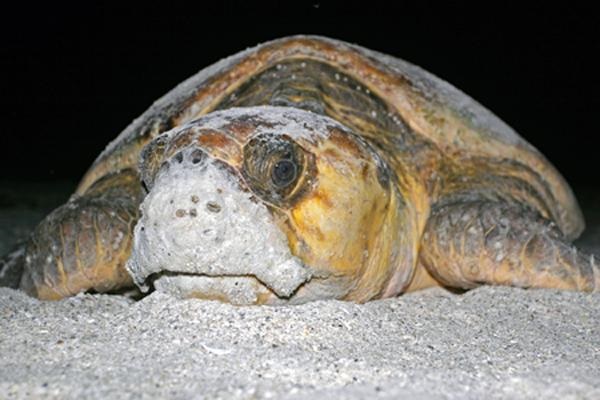
by Erik Lovestrand | May 22, 2016
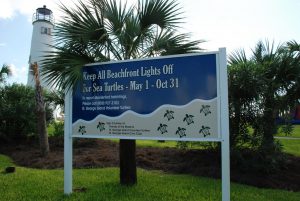
Awareness is Growing!
Photo by: Aprile Clark
That is, when it comes to lights on our homes and businesses near their nesting beaches. Humans have long-known that artificial light can have negative consequences for many nocturnal animals, including nesting and hatching sea turtles. However, it has only been through fairly recent research that we are beginning to understand the reasons behind some of these effects and developing better lighting (or non-lighting) strategies and alternatives to protect our treasured marine turtle species.
Mother sea turtles that nest on Florida Panhandle beaches are “hard-wired” for nighttime activity when it comes to digging their nest cavities and depositing eggs. Likewise, their babies typically leave their sandy nests under cover of darkness, scampering to the Gulf of Mexico. This nocturnal behavior is important for avoiding predators that would have an easy meal of a baby turtle crossing the open beach in the light of day. However, even hatchlings emerging at night face a number of other obstacles. Once in the water there are a many aquatic predators that will not hesitate to gobble up a baby turtle. On average, it is estimated that only about 1 in 1000 babies survive to reach adulthood. With those odds, it would be wise for us to do anything we can to minimize additional threats or hazards during the short but crucial time these marine reptiles spend on the narrow thread of beachfront that we share with them.
One thing we can do involves reducing the disorienting effects of artificial light near our sea turtle nesting beaches. The term “phototactic” is used to describe organisms that are stimulated to move towards or away from light. Nesting females have been shown to avoid bright areas on the beach but hatchlings tend to be attracted to the brightest source of light when they emerge from the sand. On a nesting beach with no artificial lighting, any natural light from the moon or stars is reflected off the water, creating a much brighter horizon in that direction. This naturally attracts the hatchlings in the right direction. Lights from human sources can appear very bright in comparison and quite often draw babies over the dunes and into harm’s way on roadways, from predators, or simply by exposure once the sun comes up.
Many beachfront property owners have learned about this threat and have taken this issue to heart by reducing the amount of light on their property and eliminating or replacing lights visible from the nesting beach with sea turtle-friendly lighting. There are three rules to follow when retrofitting or installing new lighting near the beach.
- Keep it Long: Long-wave-length lighting that is still in the portion of the spectrum visible to humans includes amber, orange and red light. Manufacturers are now making highly efficient LED bulbs that are certified by the FWC as turtle-friendly.
- Keep it Low: Many times lighting needed for safety of access can be placed low enough to be unseen from the nesting beach.
- Keep it Shielded: Fixtures that are in line-of-site to the nesting beach need to be recessed to shield the bulb from being directly visible. The correct long-wave-length bulb should also be used in these shielded fixtures.
Remember, exterior lighting is not the only danger turtles face from our lights. Unobstructed interior lights seen through windows and doors can be just as detrimental. The best solution here is to tint beach-facing glass with a 15% transmittance tinting product. This will save money on cooling bills as well as protect interior furnishings and avoid the possibility that someone in your house might leave the blinds or curtains open accidentally during turtle season. If you have questions regarding turtle-safe lighting practices in Florida there are many resources available through the Fish and Wildlife Conservation Commission the National Marine Fisheries Service, the Sea Turtle Conservancy, and your local UF/IFAS County Extension offices. If you really want to get into the nitty-gritty of turtle lighting and ways to protect turtles check out this FWC publication on assessing and resolving light pollution problems and this model lighting ordinance from UF’s Levin College of Law. Most Florida coastal counties have already adopted sea turtle lighting ordinances so you should also check your local county codes for this issue. Let’s help keep sea turtles in the dark, where they need to be.
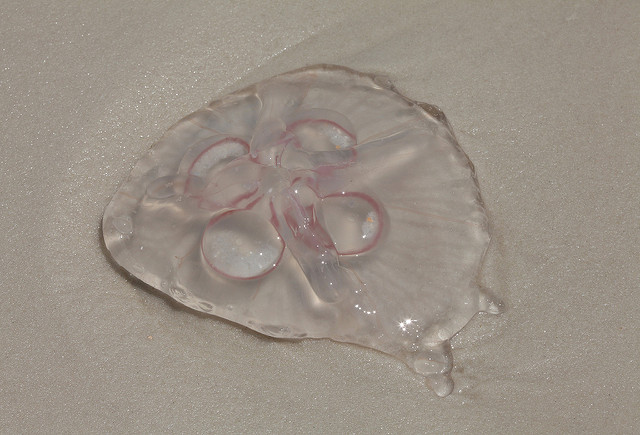
by Erik Lovestrand | Mar 25, 2016
Summertime and swimming at the beach just go together naturally in Florida with our state’s more than 1,000 miles of coastline. Many fond memories are created along these salty margins and the Panhandle region of the state has some of the top-rated beaches in the world. It is a great place to experience a relaxing, cool dip in the Gulf of Mexico on a balmy summer day. One thing to be aware of though is the possibility of an encounter with one of the Gulf’s “stinging” inhabitants and what to do if this occurs.
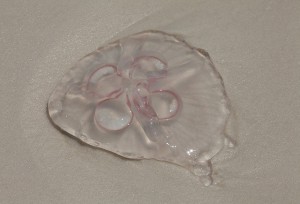
The Moon Jelly is a Common Inhabitant Along Panhandle Shores. Photo courtesy Florida Sea Grant
There are actually several different organisms that have the capability to sting. This is primarily their mechanism for capturing food but it may also serve to deter predators. Most belong to a group of organisms called “Cnidarians,” which includes the jellyfish. Most jellyfish are harmless to us and are important food sources for many other marine creatures, including some sea turtles, fish and even other jellies! Some species are even dried, shredded and eaten by humans. However, there are several types of jellyfish that will inflict a sting when brushed against and some that are actually a serious hazard. Keep in mind that people also react differently to most venoms, exhibiting varying degrees of sensitivity. The most dangerous types include some of the box jellyfish species (visit HERE for general map of worldwide jellyfish fatalities), and the blue-colored Portuguese man-o-war, which is sometimes common on our shores after sustained southerly winds during summer. A few of our locally common species that cause pain but of a generally less-severe nature include the moon jelly, sea nettle, and cannonball jellyfish. We even have some species of hydroids that look very much like a bushy brown or red algae. They are usually attached to the bottom substrate but when pieces break off and drift into the surf they can provide a painful encounter.
If you are stung there are a couple of things you can do to help and a couple of things you should not do. First, move away from the location by getting out of the water so you don’t encounter more tentacles. Carefully remove any visible tentacle pieces but not with your fingers. You should also change out of swimwear that may have trapped pieces of tentacles or tiny larval jellyfish against the skin. Do not rinse the area with fresh water as this causes the remaining stinging cells to fire their venomous harpoons. If symptoms go beyond a painful sting to having difficulty breathing or chest pain you should immediately call the Poison Information Center Network at 1-800-222-1222 or call 911.
Another thing to watch for in areas where public beaches display the beach warning flag system is a purple flag. This flag color at the beach indicates dangerous marine life and quite often it is flown when jellyfish numbers are at high levels. All of this is being written, not to scare you away from our beaches, but to help you enjoy our beautiful coastline with a little better understanding of what is out there and what to do if you happen to have a brush with a jellyfish. The vast majority of encounters are a minor irritation in an otherwise pleasant experience.
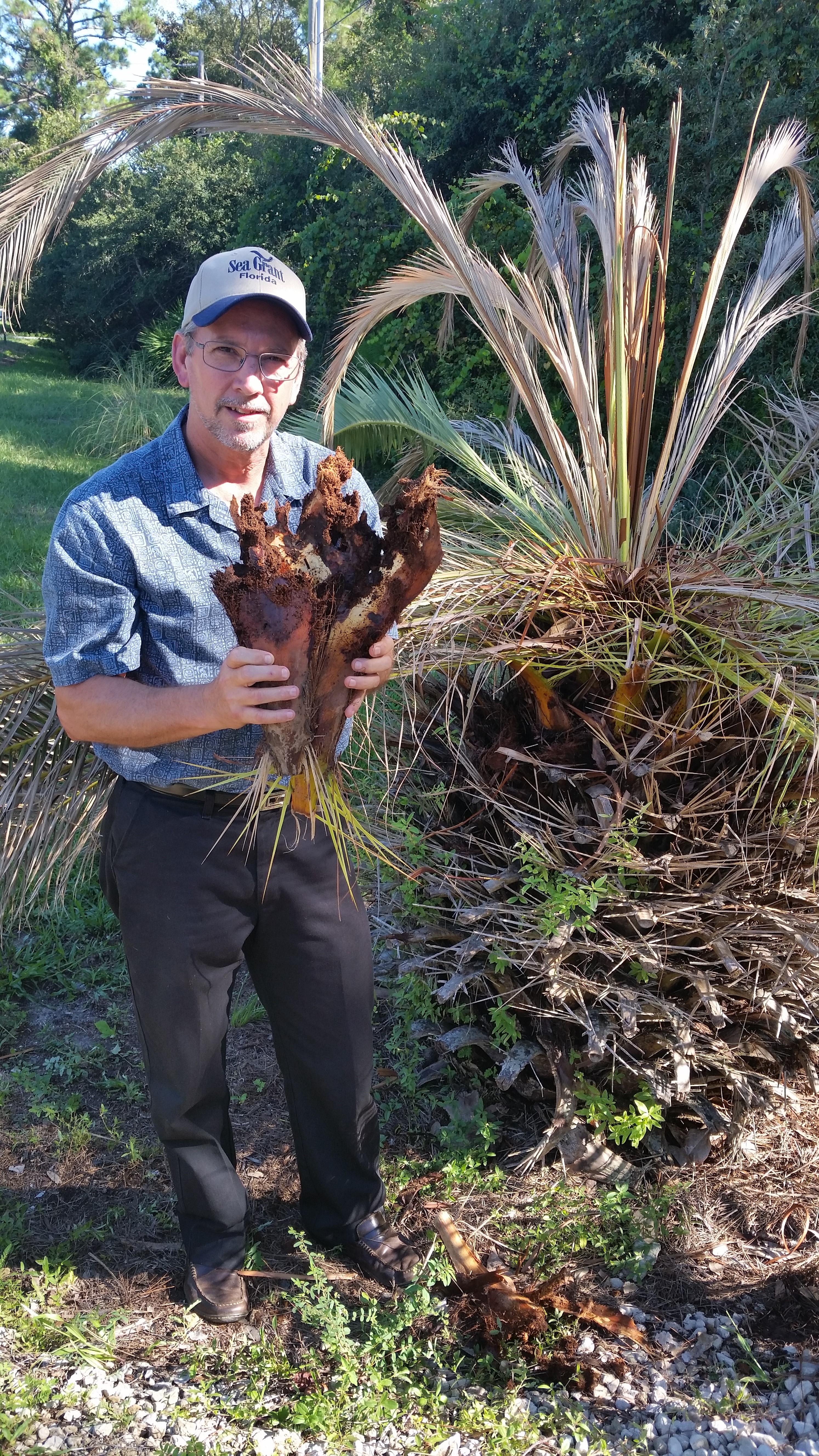
by Erik Lovestrand | Oct 2, 2015
Anyone who has had a treasured palm tree annihilated by palmetto weevils (Rhynchophorus cruentatus) knows the pain of losing a long-lived tree from the home landscape. These large, native weevils are adept at working unnoticed inside a palm to the point of terminal damage. Typically, by the time you notice that the tree is declining and fronds begin to turn brown there is likely no hope of salvaging the situation. By then the larval grubs have already damaged the tree’s growing bud to the point of no return. At this stage the recommended procedure involves removing the tree, cutting it up and burning it to prevent the invading long-snouted critters from moving over to neighboring palms.
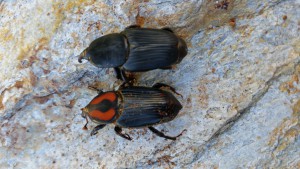
Color and size of adults is quite variable.
However, as frustrating as this is, if we step back and look at the bigger picture it is apparent that even our most aggravating native insect pests are part of the natural web of life and local plants have adapted to survive these “give and take” relationships on the population scale.
Palmetto weevils establish in a new tree when adult females lay their eggs in the crown of the tree and larvae hatch to burrow into the soft terminal bud. It is larval feeding that does the lethal damage. Larvae are large, white, legless grubs that can reach lengths of six-seven centimeters. When larvae are mature they create a cocoon inside the tree from tree fibers and pupate there before hatching into adults to start the cycle over. Grubs can be found in any part of the tree but really need the softer, growing parts for food, such as in the base of the living fronds and the terminal bud.
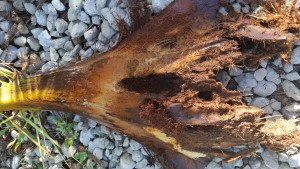
Weevil damage at base of frond.
The condition created by these burrowers is often referred to as “popped neck,” where the top of a palm tree dies and caves over. If you are in the process of removing a dying or dead palm due to the crown dying it would be a good idea cut through the top section with a chainsaw to see if weevil damage is evident in large (about ½ inch) diameter tunnels. If a live specimen of an adult can be captured in a jar it would be worth a visit to your local Extension office for a positive identification to make sure you aren’t dealing with another similar species of non-native weevil that has not been documented in Florida yet. The red palm weevil (Rhynchophorus ferrugineus) has now been found in the U.S. at Laguna Beach, California. Coloration varies by individual bug but a positive i.d. can be obtained by sending the specimen to UF’s laboratory in Gainesville. For further information on palmetto weevils refer to the EDIS fact sheet at this web link.
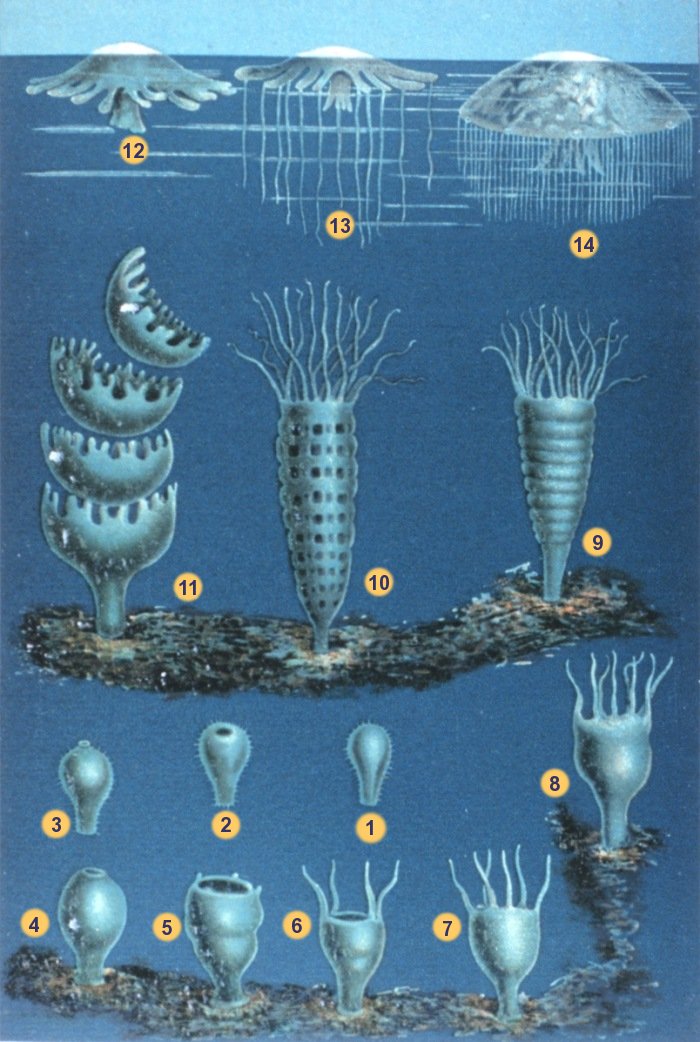
by Erik Lovestrand | May 29, 2015
![Life Stages of the True Jellyfish: Photo: By Matthias Jacob Schleiden (1804-1881) [Public domain], via Wikimedia Commons](https://nwdistrict.ifas.ufl.edu/nat/files/2015/05/Schleiden-meduse-2-202x300.jpg)
Life Stages of the True Jellyfish: Photo: By Matthias Jacob Schleiden (1804-1881) [Public domain], via Wikimedia Commons
“Ouch, something just stung me.” This is a common phrase to hear someone say (I’ve heard myself say it) while enjoying the otherwise soothing waters along our beautiful Gulf Coast. We host an amazing variety of marine organisms that possess the ability to sting when contacted. I’m referring to organisms in the phylum Cnidaria (pronounced “ni-dair-ee-ah”), which includes about 10,000 species that have been identified. There is general agreement on the classification of five different classes of cnidarians, all of which have stinging cells, but most of which are not dangerous to humans. These include Class Anthozoa (anemones and corals), Class Cubozoa (box jellyfish), Class Scyphozoa (true jellyfish), Class Staurozoa (stalked jellyfish) and Class Hydrozoa (hydroids i.e. Portuguese man o’ war). I’m always intrigued by the origin of scientific names so here is a slight tangent for you on the group names (Cnides: from the greek meaning nettle)(Antho: flower-like; Cubo: cube-shaped; Scypho: cup-shaped; Hydros: sea serpent; Stauro: cross-shaped). The term “zoa,” of course, refers to animals.
Most of the time you are stung in our local waters it involves the classes Hydrozoa or Scyphozoa. The Hydrozoans are a complex group of organisms but most species go through two distinct stages during their life cycle. The hydroid stage takes the form of a polyp which is composed of a stalk and tentacles at the end. Polyps can be single but are often colonial, connected by tube-like structures. Most polyps are specialized for feeding but others are used to reproduce. Reproductive polyps lack tentacles but have many buds which form the medusa stage of the organism for reproduction purposes. Medusae of the hydroids are similar in design but typically smaller than the medusae of the true jellyfish. Some hydroids also have specialized defensive polyps with numerous stinging cells and one species even has a specialized polyp that develops into a large balloon-like float that the others attach to (the man o’ war). There is one specific type of hydroid in our area that closely resembles a piece of branching brown algae, such as Sargassum. The polyps are scattered along the branches and when brushed against they fire their nematocysts (stinging cells) producing a painful sting. The burning sensation can last for several minutes and you would have sworn the only thing around you was a harmless piece of drift algae.
The true jellyfish, of Class Scyphozoa, also go through a polyp and medusa stage. The polyps of this class are typically single and settle to the bottom as larvae and attach themselves. Over time the polyps mature and produce other polyps by budding, or bud medusae off their upper surface. These jellyfish medusae are microscopic at this stage and many take years to reach maturity, complete with a cup-shaped (scypho= cup shaped) bell and tentacles hanging beneath.
The subsequent lives of these translucent marine creatures is no less intriguing than the processes involved in their development. Check out this website from the Smithsonian for more great information. The next time you feel the burn of a host of nematocysts injecting you with their potent venom, I dare you to stop for just a second to be amazed by the fascinating creature that you have just met. If you can pull this off you are well on your way to becoming the quintessential nature nut! Click here for helpful information if you are stung.
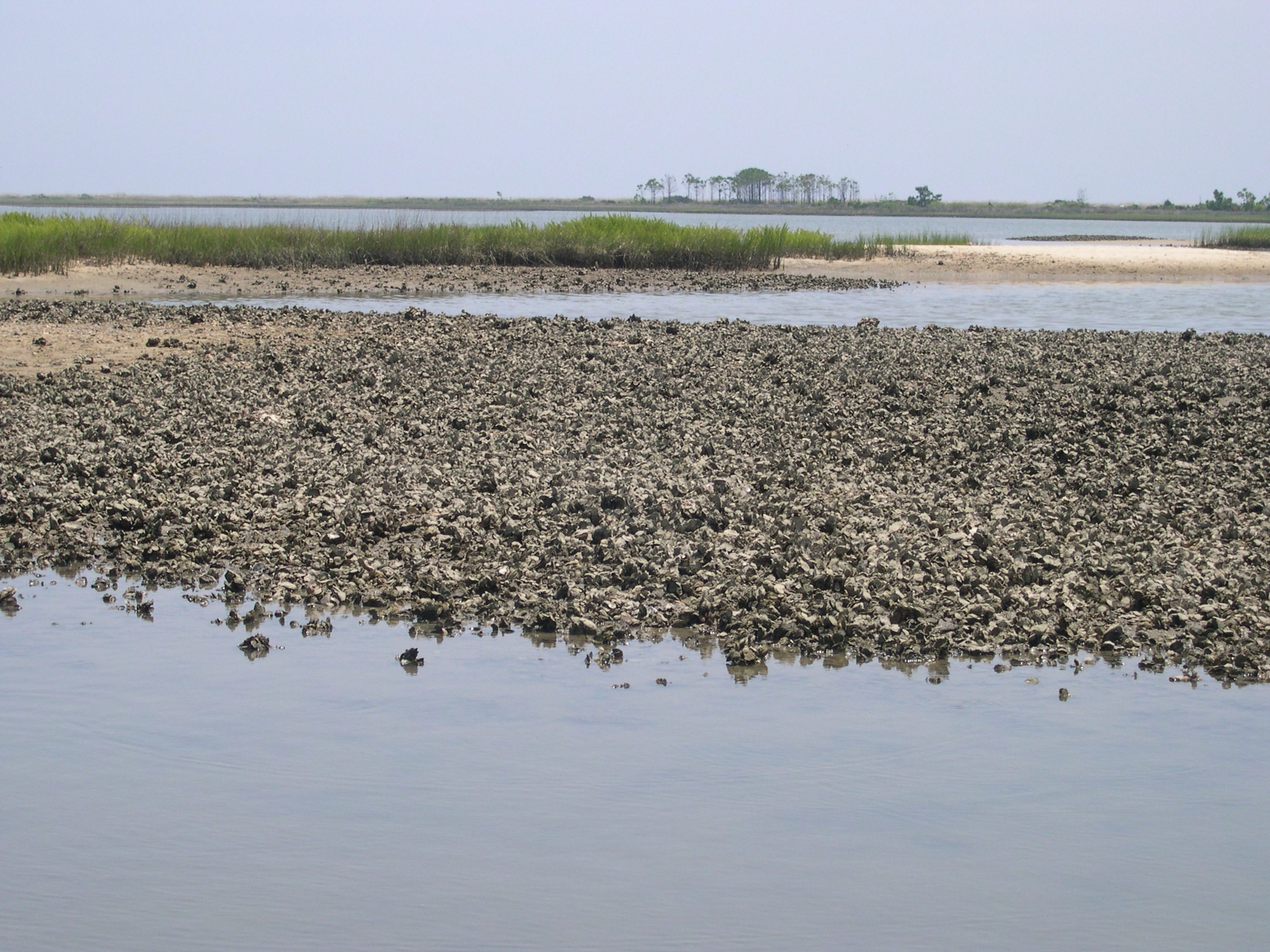
by Erik Lovestrand | Feb 6, 2015
Nature has provided us with an incredible resource in the diverse assemblage of molluscan shellfish that inhabit our coastal bays and estuaries. One bivalve species in particular provides many human benefits. The eastern oyster (Crassostrea virginica) has not only proven to be a preferred food species for people but also derives many vital ecosystem services through its existence in our near-shore estuaries. Oysters are born as planktonic larvae that drift in the water for about 2 weeks. They are called a spat when they settle out of the water column and glue themselves to a suitable hard surface, such as another oyster shell, and begin to grow their own shell. Oysters feed on particulates in the water throughout their life and when mature can filter as much as 50 gallons per day. Because of this life style they provide some degree of water purification and improvement in water clarity. The structure of an oyster reef is also a valuable habitat component which provides shelter for a plethora of small creatures that support a vast food web in the estuary ecosystem.
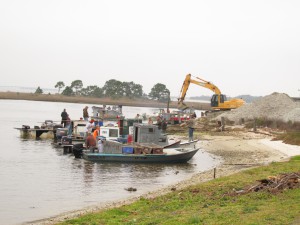
Oystermen participate in shelling program for Apalachicola Bay
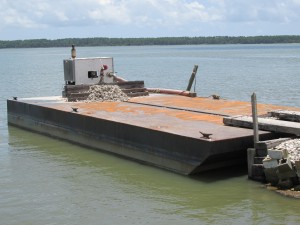
Barges will also be used to relay shells for replenishing oyster habitat.
Although we have several native species of oysters in the Gulf of Mexico the eastern oyster is the only species that supports a commercial industry. in Florida, the bulk of that industry has traditionally been centered around Apalachicola Bay in the mid-Panhandle region of the state. This one estuary system typically produces 90 percent of the state’s oyster crop and 10-13 percent of the nation’s harvest. Some good harvest years have yielded 4-6 million pounds of oyster meat (shells excluded) from this single bay. In recent years however there has been a dramatic decline in oyster abundance. The industry, along with concerned natural resource managers, is seeking to rebuild numbers to a sustainable harvest level. The reasons for this precipitous drop in numbers is the subject of much debate but savvy natural resource professionals believe a combination of factors have been involved over several years to cause the current situation.
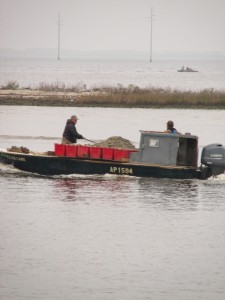
Fossil oyster shell being relayed to bay bottom.
So, how do you bring back a thriving oyster industry from the brink of collapse? Several factors need to be considered and addressed as part of a holistic management approach. At the present time there are two primary mechanisms being employed to support increased oyster recruitment to Apalachicola Bay. The first involves “planting” a suitable material on the bay bottom for oyster spat attachment and growth. In the past this has primarily consisted of oyster shells from the shucking plants. More recently the industry has been employing the use of fossil shell material from a local mine. Oystermen are being employed to transfer the shell from land-based loading areas to the designated deposition sites in the bay. Funding is also forthcoming to allow shelling by barges to cover more area. The other strategy to assist with recovery has involved the use of regulatory authority in consultation with local experts and oystermen with decades of experience on the bay. This approach can reduce the harvest pressure on oysters and support a more rapid recovery, given proper conditions in the estuary. Bag limits have been reduced, enforcement has been stepped up to ensure compliance with the rules, and harvest areas have been adjusted.
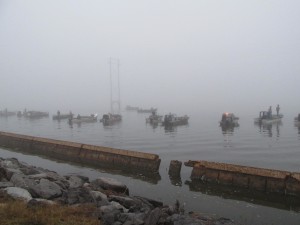
Oystermen line up early to receive shell for relay project.
There are, of course, other important aspects to the solution for bringing back the thriving industry of the past and many of them relate to natural cycles of drought and flooding. Increasing human demands for water from the river system that feeds the bay tend to magnify the effects of natural drought cycles. If salinity remains high for longer periods there is an increased pressure from oyster predators that typically are limited by lower salinity. Factors related to oyster diseases and parasites are also in the mix. To say that it is a complicated situation would be an understatement. Researchers who have studied the system for their entire careers find it difficult to quantify the problems and solutions for this large, complex natural ecosystem that has been an important cultural and economic component of Florida’s makeup since early humans roasted or cracked open the first oyster. Hopefully, with enough concerned partners working towards effective management strategies we can once again enjoy in abundance the wholesome, delicate morsels that have been called the food of the gods.
Article by: Erik Lovestrand
Franklin County Extension Director
Sea Grant Regional Agent II









![Life Stages of the True Jellyfish: Photo: By Matthias Jacob Schleiden (1804-1881) [Public domain], via Wikimedia Commons](https://nwdistrict.ifas.ufl.edu/nat/files/2015/05/Schleiden-meduse-2-202x300.jpg)




